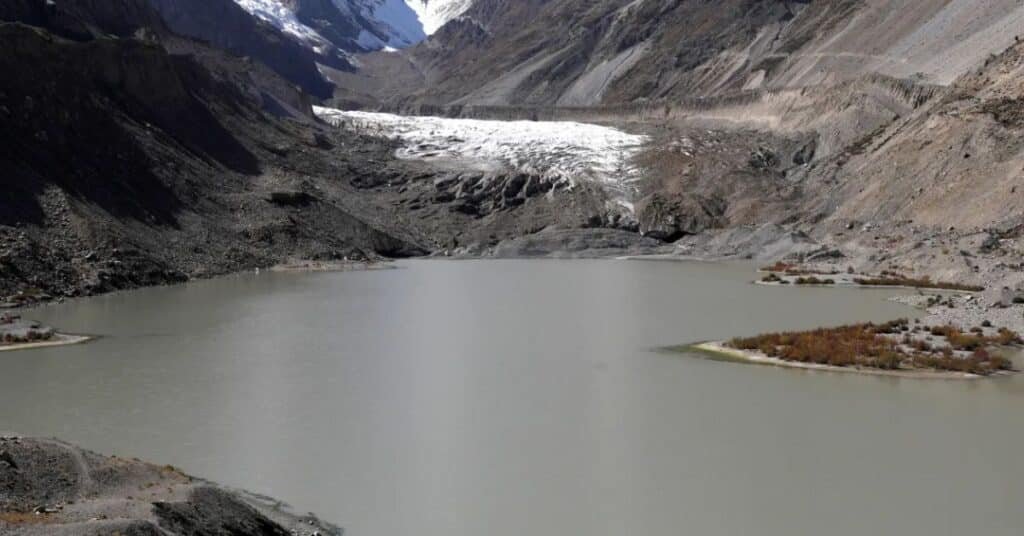By: Zulfiqar Ali, Shahzeb Afzal, Shujaat Mir (Kashmir Investigation Team)
MUZAFFARABAD (Kashmir English): Azad Kashmir has recently gained access to the Green Climate Fund (GCF) financing for the first time, but the situation in the region has already worsened, even before the arrival of this funding. It remains uncertain how long it will take for this funding to materialize, while the environmental crisis continues to escalate, and the impact of climate change is already evident.
Experts have warned that the glaciers of Azad Kashmir, found exclusively in Neelum Valley, have been retreating at an alarming rate over the past two decades. They state that this glacier melt is primarily driven by rising temperatures, deforestation, global warming, shifting weather patterns, and human activity.
Neelum Valley, renowned for its stunning snow-capped mountains, meadows, lakes, and rivers, is grappling with these unprecedented environmental challenges. The retreat of its glaciers has far-reaching effects on local ecosystems, water resources, and agriculture, according to environmental experts. They added that local communities, heavily reliant on forests for fuelwood and timber smuggling, have further contributed to the problem by cutting down trees at an unsustainable rate.
According to a paper by Sardar Muhammad Rafique Khan, Deputy Director of the Environment Protection Agency, titled “Impacts of Climate Change on the Water Resources of Azad Jammu & Kashmir, Kashmir Himalaya,” published in the Journal of Earth Science & Climatic Change for the 8th International Conference on Environment and Climate Change, the total glacier area in 2000 was 15,110 hectares.
By 2010, this had decreased to 13,520 hectares, a loss of 1,590 hectares over the course of ten years, which, as stated in the paper, means 159 hectares every year.
The paper further reports that from 2010 to 2017, the glacier area decreased to 11,350 hectares, with a loss of 2,170 hectares in just seven years, or 309 hectares annually. Therefore, the glacier area has decreased by approximately 24.9% from 2000 to 2017, with an average loss of 220 hectares every year from 2000 to 2017. Although no further studies are available after 2017, it is assumed that the glaciers have continued to melt at an even faster rate.
If the glaciers continued to melt at a rate of 309 hectares per year after 2017, by 2024, the total loss of glaciers would reach approximately 5,923 hectares, accounting for a 39.2% reduction in glacier area. If this rate persists, the glaciers could disappear entirely in about 30 more years, around 2054.
Impact of Glacier Melting in the Region
A Growing Threat of Glacier Lake Outburst Floods (GLOFs)
In his paper, Dr. Muhammad Rafique Khan also points to the formation of glacial lakes as a direct consequence of the rapid melting of glaciers. These lakes, primarily in the Neelum district, have increased from 50 lakes (spanning 499 hectares) in 2000 to 60 lakes (spanning 556 hectares) in 2017. Three of these lakes have been identified as having the greatest potential to cause Glacier Lake Outburst Floods (GLOFs).
Dr. Rafique Khan emphasizes the growing risk of GLOFs. “When glaciers melt, glacial lakes form, which can lead to catastrophic GLOFs,” he explains. He highlights a particularly concerning lake above Lunda Narr, Shonthar, Neelum Valley, which sits beneath a glacier. “If the thickness of this glacier decreases shortly and fractures, it could collapse into the lake, triggering a flood that would endanger the 5,000 to 6,000 people who live near the Shounter water channel upstream from Lunda Narr,” he warns.
A separate study, published in the Pakistan Journal of Meteorology in January 2012, titled “Monitoring and Estimation of Glacial Resources of Azad Jammu and Kashmir,” used remote sensing and GIS techniques to map over 224 glaciers in the region, with the majority concentrated in the Neelum Valley. The study revealed that these glaciers hold around 4.9 cubic kilometers of ice reserves and are responsible for shaping the region’s glacial ecosystem. Additionally, the study identified 76 glacial lakes, covering approximately 545 hectares. Of these lakes, 40 were found to be larger than 2 hectares in surface area.
Erosion-type Lakes as Evidence of Glacier Melting
These lakes are categorized into six types, with 53% classified as erosion-type lakes. The prevalence of erosion-type lakes is a clear indicator of glacier recession, likely influenced by global environmental changes. These findings underscore the ongoing environmental changes in the region and the potential consequences of further glacier retreat. Erosion-type lakes provide additional evidence that glaciers are melting and continue to recede.
Intensified Weather Patterns and Temperature Rise
In addition to the ongoing glacial retreat, climate change is intensifying other extreme weather events in the region. Dr. Rafique Khan highlights the increased frequency of cloudbursts in Neelum Valley and Leepa Valley since 2019. At least six such incidents have occurred in recent years, resulting in significant loss of life and property damage, further exacerbating the threats posed by climate change.
Dr. Khan notes that over the past fifty years, Azad Kashmir has experienced a concerning rise in average temperatures, which have increased by 2°C. He warns that this warming trend could escalate, with projections suggesting a further temperature rise of more than 3°C by the end of the 21st century. Dr. Khan adds that such an increase could have severe consequences for human health, biodiversity, and the availability of water resources—critical elements for the region’s survival.
Disrupted Weather Patterns
Dr. Khan observes a dramatic shift in the region’s seasonal weather patterns, with both snowfall and rainfall becoming less frequent in winter. Traditionally, snowfall occurred in the early winter months of November and December, but now it is being recorded in February, March, and even June. “The timing of snowfall has been disrupted, resulting in unexpectedly heavy snowfalls,” Dr. Khan explains. For instance, Dr. Khan noted that in both 2021 and 2023, the region experienced significant snowfall in June, with mountains accumulating 3 to 4 feet of snow.
This disruption in snowfall timing, coupled with reduced rainfall, has had cascading effects on groundwater recharge, agriculture, and overall weather patterns. Dr. Khan emphasizes that these changes are impacting local ecosystems, agricultural productivity, and livelihoods. Snowfall has become less consistent, and dry spells have become more frequent, he adds.
Dr. Khan further points out that these changes in snowfall patterns are also damaging glaciers. Snow that falls during the early winter months of November and December typically lasts longer, helping to protect glaciers and maintain the groundwater table, according to Dr. Khan. However, he explains, with delayed snowfall, the snow melts more quickly due to the warmth of the ground, resulting in significant harm to glaciers. This early melt leads to more rapid glacier runoff during the summer, exacerbating the situation.
Shifting Seasonal Patterns
Dr. Sardar Muhammad Rafique Khan has observed a noticeable shift in the timing of the seasons, with the start and end dates of each season now differing from the past. Over the past 60 years, Dr. Khan notes that data indicates a significant change in seasonal patterns in Azad Kashmir. The summer season has increased by 45 days, compared to a 30-day increase across Pakistan as a whole. In contrast, Dr. Khan explains that the durations of winter, autumn, and spring have decreased.
Climate Change’s Impact on Crops
Local people report that climate change is directly affecting agriculture in Azad Kashmir. In particular, they mention that the Shounter and Gurez valleys in the Neelum District have been severely impacted by unexpected off-season snowfall. According to locals, large potatoes, which typically weigh up to two kilograms, suffered the most damage as they could not mature and were ruined by the snowfalls in June of both 2021 and 2023. Additionally, locals explain that crops typically harvested in the autumn are dried and stored for use during the winter.
However, due to the summer snowfall, these crops were destroyed, making it difficult for them to prepare enough food for the winter months. Furthermore, to meet the feed requirements for livestock, locals plant maize in the summer, which they dry and use as fodder during the winter. However, locals state that the snowfall prevented the maize crop from being harvested, further complicating their ability to secure animal feed.
Water Scarcity
Experts explain that climate change is one of the main causes of water scarcity in Azad Kashmir. They point out that traditional springs, which were once a primary source of fresh water, are drying up at an alarming rate. As glaciers continue to recede, experts warn that these water sources will become even more unreliable, exacerbating the crisis for local communities that depend on them for drinking water and, in some cases, irrigation. Experts emphasize that the combined effects of glacier melt and drying springs will severely impact the region’s water security.
Wild Boars as Climate Indicators
The presence of wild boars in areas where they were previously uncommon is now being seen as an indicator of climate change. These animals typically migrate into new regions in search of food and habitat, signaling ongoing environmental shifts.




